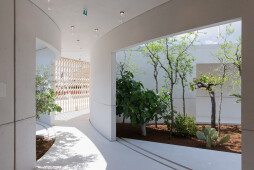Archaeologies of Green, the pavilion of the Kingdom of Bahrain, at the Expo Milano 2015 is a poetic interpretation of the cultural agrarian heritage of the country, which stems from the ancient civilization of Dilmun.
With ten distinctive fruit gardens, containing trees that will be fruit–bearing at different moments throughout the six-month duration of the exhibition, the pavilion also features archaeological artifacts that celebrate the millennia long tradition of agriculture and perpetuate the many myths of Bahrain as the location of the Garden of Eden and the land of the million palm trees.
Built out of white prefabricated concrete panels, the pavilion will be moved to Bahrain at the end of the Expo and once rebuilt will serve as a botanical garden. The prefabricated components of the buildings, visible through the seams that connect them to one another, loosely refer to the inherent and distinguished forms of the archaeology of Bahrain.


































